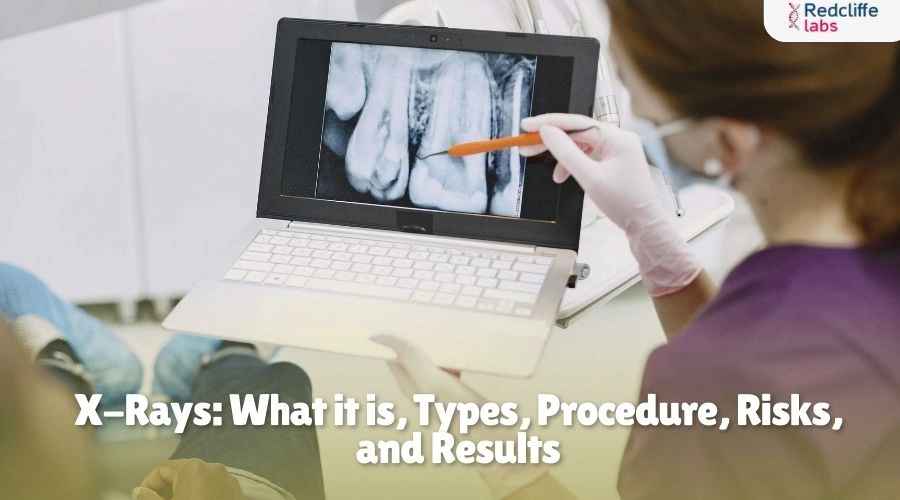X-Rays: What it is, Types, Procedure, Risks, and Results

Medically Reviewed By
Dr. Geetanjali Gupta
Written By Kirti Saxena
on Apr 11, 2025
Last Edit Made By Kirti Saxena
on Jul 19, 2025

Have you ever had an X-ray? How was the experience? Did you feel safe, or were you scared?
You all might know why we use X-rays. But do you know the importance of X-rays?
An X-ray is a quick and painless procedure to produce images of the inside of the body.
It is a very effective way to examine the bones and helps to detect complications.
X-rays are usually performed in a hospital by trained specialists called radiographers. However, other healthcare professionals, such as dentists, can perform them. Read on to learn more about X-ray, its types, purpose, procedure, and more.
What is an X-ray?
An X-ray is a type of electromagnetic radiation that passes through the human body to create a picture of the inside of the body. This is also known as radiography. Wilhelm Roentgen first discovered X-rays in 1895. X-rays revolutionized the medical field and are now one of the most common diagnostic tools used worldwide.
X-ray imaging works because different tissues in the body absorb X-rays at different rates. Dense materials like bones absorb more X-rays, which appear white on the image, while softer tissues absorb low X-rays in shades of gray. This contrast helps doctors identify fractures, infections, tumors, and other conditions.
Common Types of X-rays
There are several different types of x-ray, including:
- Plain radiography (plain X-ray)- The most common type of X-ray used to produce a single, static image of an area of the body. Examples include chest X-rays, bone X-rays, and abdominal X-rays.
- CT (computed tomography) scanning: This scan uses multiple X-ray images taken from different angles to create cross-sectional images (slices) of the body.
- Fluoroscopy allows doctors to view the movement and passage of contrast agents throughout the body, producing moving images of an organ.
- Mammography — an x-ray of breasts to detect breast cancer and other conditions.
- Angiography — an x-ray of your blood vessels. It helps to diagnose conditions like aneurysms and blockages in blood vessels.
- Bone density scan — This type of X-ray measures bone density and diagnoses conditions like osteoporosis
- Dental X-rays—There are two types of dental X-rays: intraoral and extraoral. Intraoral captures images of teeth and surrounding structure, while extramural captures a broader view of the jaw and skull. Examples include panoramic X-rays, cephalometric X-rays, and cone-beam computed tomography (CBCT).
The following are common types of X-rays:
-
Abdominal x-ray
-
Barium x-ray
-
Bone x-ray
-
Neck x-ray
-
Lumbosacral spine x-ray
-
Upper GI
-
and
-
small bowel series
-
X-ray of the skeleton
-
Pelvis x-ray
-
Sinus x-ray
-
Skull x-ray
-
Thoracic spine x-ray
-
Chest x-ray
-
Dental x-ray
-
Extremity x-ray
-
Hand x-ray
-
Joint x-ray
When do you need an X-ray?
X-rays serve multiple medical purposes, such as:
-
Diagnosis of certain conditions- X-rays help diagnose fractures, pneumonia, tumors, and infections.
-
Monitor disease progress—X-rays track disease progress or treatment effectiveness.
-
Guidance for Procedures- X-ray imaging assists in orthopedic surgeries, biopsies, and dental treatments.
-
Screening- Routine screenings, such as mammograms, help detect diseases early.
Your healthcare professional may recommend you an X-ray for various medical reasons, including-
-
To check a broken bone or fracture
-
To look at foreign objects in your body
-
To find structural problems in your joint and soft tissues.
-
Look for signs of infections in your lungs
-
To identify the cause of swelling and pain.
-
Helps to diagnose arthritis
-
Can help to find out the causes of abdominal pain
-
Detects certain types of cancers
-
Helps to detect tooth decay
Preparation Required for an X-ray
X-ray is a simple procedure. You need to follow the below instructions, including-
-
Remove Metal Objects—Your healthcare provider will ask you to remove jewelry, watches, and metallic accessories before you take an X-ray.
-
Wear Comfortable Clothing- Loose, comfortable clothing is ideal; hospitals may also provide gowns.
-
Inform Your Doctor - Inform your doctor if you are pregnant, have implants, or have any metal devices inside your body.
-
Fasting (if required) - Some X-rays, like abdominal X-rays, may require fasting before the procedure.
-
Contrast Dye (if needed) - Some X-rays use contrast materials (barium or iodine-based dyes) to enhance imaging, which may require additional preparation.
The procedure of an X-ray
A radiologist will perform an X-ray. The procedure is quick and painless. Here's what happens during an X-ray screening-
-
Your doctor will help you choose a position to create clear images. Depending on the type of X-ray being taken, the patient may be asked to sit, stand, or lie down.
-
They may also provide you with a lead apron to cover sensitive areas and minimize radiation exposure.
-
The X-ray machine directs a controlled amount of radiation toward the targeted body part. The rays pass through the body, creating an image on a digital or film-based detector.
-
The process will take only a few minutes to get the X-ray images.
-
Post-Procedure- After completing the procedure, you can resume your daily activities immediately.
Is There Any Risk of X-rays?
The X-rays use a small amount of radiation to create images of your inside body. The level is generally safe for adults but might not be good for developing babies. If you are pregnant, inform your doctor before your X-ray. Your healthcare professional may suggest a different imaging method, such as an MRI.
However, if you have an X-ray to detect the cause of a painful condition, such as a broken bone, you might experience some discomfort.
If you ingest a contrast material before your X-ray, it may cause side effects, including-
-
Hives
-
Nausea
-
Itching
-
Lightheadedness
-
A metallic taste in your mouth
X-Ray Results
After your scan, you can change your clothes. Your X-ray results will be available within the same day. Consult your reports with your doctor to determine how to proceed.
The results may show:
-
Normal Findings - No abnormalities, fractures, or infections are detected.
-
Fractures or Bone Damage - Cracks, breaks, or deformities in bones.
-
Infections - Presence of pneumonia, tuberculosis, or bone infections.
-
Tumors or Abnormal Growths - Lumps, cysts, or cancerous masses.
-
Joint Issues - Signs of arthritis, bone spurs, or joint dislocations.
-
Lung or Heart Conditions - Enlarged heart, fluid in lungs, or blocked airways.
Depending on your results, your doctor may order additional tests to make an accurate diagnosis. Diagnosis For example, your doctor may recommend imaging scans like MRIs, CT scans, or biopsies for a more detailed diagnosis.
Also Read: https://redcliffelabs.com/myhealth/radiology/how-to-find-best-x-ray-near-me/
Final Thoughts
X-rays have been used for more than a decade now. This is one of the oldest and most reliable technologies with no or minimal side effects. X-ray allows healthcare providers to know what is going on inside your body. However, modern X-rays provide far more detailed pictures and use less radiation. If your doctor recommends an X-ray, get it from your nearby best radiography lab. However, consult your doctor before your X-ray if you have any questions.
FAQ’s
What is X-ray used for?
X-rays create images of internal structures, primarily bones and joints. These X-ray images help to diagnose conditions and injuries, including fractures, infections, and tumors.
What is the full form of X-rays?
The full form of "X-rays" is X-radiation, a type of electromagnetic radiation.
What is the principle of X-ray?
The principle of X-ray imaging relies on the differential absorption of X-rays by different tissues. It creates a visual representation of internal structures. Denser tissues absorb more X-rays, which appear lighter on the image, while less dense tissues allow more X-rays to pass through, appearing darker.
Why x-ray vs MRI?
X-rays are quick, inexpensive, and good for visualizing bones, while MRIs provide detailed, radiation-free images of soft tissues and organs, making them suitable for different diagnostic needs.
How many X-rays are safe?
No numbers are considered safe for X-rays. To minimize radiation exposure, healthcare providers follow the ALARA principle (As Low As Reasonably Achievable).
Leave a comment
1 Comments
B D GUPTA
Apr 14, 2025 at 3:57 PM.
What is the difference between X-Ray Ultrasound CT and MRI.
Myhealth Team
Apr 16, 2025 at 2:40 PM.
X-Ray is quick and used mainly for bones and chest; it uses low radiation. Ultrasound is safe, radiation-free, and best for pregnancy and soft tissues. CT scan gives detailed cross-sectional images using higher radiation, ideal for internal injuries. MRI provides very clear images of the brain, spine, and joints without radiation but takes more time and is costlier.



